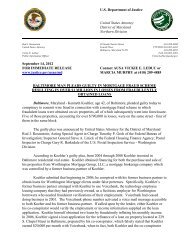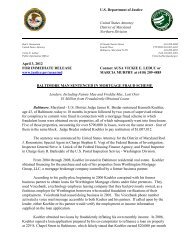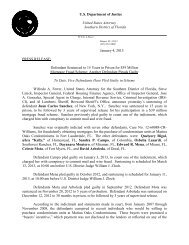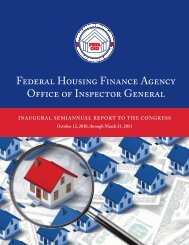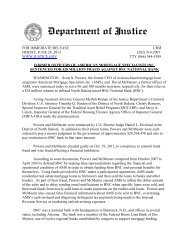FEDERAL
Sixth Semiannual Report to the Congress - Federal Housing ...
Sixth Semiannual Report to the Congress - Federal Housing ...
- No tags were found...
You also want an ePaper? Increase the reach of your titles
YUMPU automatically turns print PDFs into web optimized ePapers that Google loves.
mortgage credit. For its part, the government would<br />
explicitly provide robust oversight, protect consumers<br />
and investors, assist low- and moderate-income<br />
homeowners and renters, help stabilize the market,<br />
and respond to crises. 104<br />
In August 2013, President Obama clarified the<br />
Administration’s plan for reforming the enterprises.<br />
The Administration’s plan includes four core principles:<br />
• Put private capital at the center of the housing<br />
finance system;<br />
• Wind down the enterprises;<br />
• Ensure widespread access to safe, responsible<br />
financing, like the 30-year fixed-rate mortgage; and<br />
• Support affordability and access for renters and<br />
homeownership for first-time buyers. 105<br />
Individual members of Congress have also made<br />
proposals. For example, on June 25, 2013, eight<br />
members of the Senate Banking, Housing and Urban<br />
Affairs Committee introduced a bill, the Housing<br />
Finance Reform and Taxpayer Protection Act of<br />
2013. 106 The bill calls for greater private-sector<br />
participation in the secondary mortgage market,<br />
winding down the enterprises over five years, and<br />
creating a new government insurance entity. 107 On<br />
July 22, 2013, five members of the House Financial<br />
Services Committee introduced housing finance<br />
reform legislation, entitled the Protecting American<br />
Taxpayers and Homeowners Act of 2013. 108 The bill<br />
winds down the enterprises over a five-year transition<br />
period and reduces the government’s role in the<br />
housing finance market. 109<br />
Academics, industry experts, and interest groups also<br />
have made housing finance reform proposals.<br />
However, in spite of the diversity of sources,<br />
essentially there are only three categories of<br />
proposals: 110<br />
• Private—the private sector takes over the<br />
secondary mortgage market; 111<br />
• Public—the government takes over the<br />
enterprises’ current role; 112 or<br />
• Private/Public—the government provides some<br />
safety for private participants. 113<br />
The private model relies upon private companies<br />
to buy and securitize mortgages and to guarantee<br />
payment of principal and interest on the resulting<br />
securities. Under this model, the government does<br />
not guarantee the companies or the securities. The<br />
key to most of the private model options is to wind<br />
down the enterprises over a defined period of years. 114<br />
In theory, this will provide an incentive for privatesector<br />
participation as guarantee fees increase to what<br />
the market will bear.<br />
In the public model, a government corporation<br />
replaces the enterprises, and it buys, securitizes, and<br />
sells residential mortgages. Approved lenders pay<br />
guarantee fees to the corporation in order to ensure<br />
timely payment of interest and principal on the<br />
resulting securities. 115 This type of proposal requires<br />
the federal government to back all of the corporation’s<br />
obligations, or at least to guarantee MBS’ principal<br />
and interest payments.<br />
Many envision a private and public hybrid model<br />
for the secondary mortgage market. In the broadest<br />
context, the hybrid model calls for private participants<br />
to buy and securitize mortgages from approved<br />
lenders with some form of government guarantee. 116<br />
Such proposals tend to vary according to the level<br />
Semiannual Report to the Congress • April 1, 2013–September 30, 2013 53



